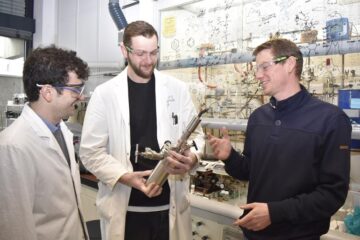Engineers create super compressible foam-like films

At the heart of the promises of nanotechnology – the emerging science of making molecular machines – are carbon nanotubes. These are tiny cylinders with remarkable properties that could improve products ranging from house paint to microchips.
Now, engineers at the University of Florida and two other universities have added another possibility: Foams used in everything from construction to cushions to packaging.
An article about the engineers’ discovery appears Friday in the journal Science.
First created in 1991, carbon nanotubes are among new forms of carbon called fullerenes because their sides mimic the geodesic domes designed by famed mathematician Buckminster Fuller. Nanotubes are infinitesimal cylinders with single or multiple walls that can be only a few nanometers wide. One nanometer equals one-billionth of a meter.
Carbon nanotubes are very strong. Mixed with conventional materials, they are already improving the performance of concrete and other products. They also have electrical and magnetic characteristics expected to make them useful in microchips and other electronics.
Engineers at the University of Florida, University of Hawaii and Rensselaer Polytechnic University appear to have opened the door to another use. Using a high-temperature furnace, the engineers grew foam-like nanotube films that proved to be super compressible.
Testing showed the films can be squeezed to 15 percent of their regular size, forming regular folded structures throughout the films.
Greg Sawyer, a UF associate professor of mechanical and aerospace engineering, said researchers “hope to infiltrate the films with solid materials to create new ’nanocomposites.’” These multifunctional nanocomposites would be useful for solid lubricating coatings in air and space applications, he said.
Media Contact
More Information:
http://www.ufl.eduAll latest news from the category: Materials Sciences
Materials management deals with the research, development, manufacturing and processing of raw and industrial materials. Key aspects here are biological and medical issues, which play an increasingly important role in this field.
innovations-report offers in-depth articles related to the development and application of materials and the structure and properties of new materials.
Newest articles

Lower dose of mpox vaccine is safe
… and generates six-week antibody response equivalent to standard regimen. Study highlights need for defined markers of mpox immunity to inform public health use. A dose-sparing intradermal mpox vaccination regimen…

Efficient, sustainable and cost-effective hybrid energy storage system for modern power grids
EU project HyFlow: Over three years of research, the consortium of the EU project HyFlow has successfully developed a highly efficient, sustainable, and cost-effective hybrid energy storage system (HESS) that…

Safer alternative for an explosive reaction
The chemical industry has been using a reaction with explosive chemicals for over 100 years – now Mülheim scientists have discovered a safer alternative. The Ritter Group of the Max…





















